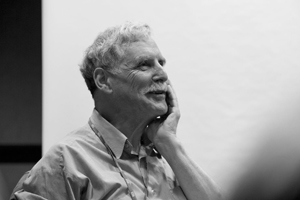On Cecil G. Helman's, "Culture, Health and Illness," 2007

On Cecil G. Helman's, "Culture, Health and Illness," 2007

"Most patients present their doctors with only the broken shards of human life—the one labeled infection, disease, suffering and pain each of these shards is only a small part of a much larger picture….the doctor will have to try and reconstruct the rest." - Cecil Helman, 2014:66, "An Amazing Murmur of the Heart: Feeling the Patient's Beat"
「たいていの患者は、医師に対して人間の生活の欠けた面 だけを見せるだけである、すなわち、感染、病気、苦しみ、痛みというラベルが貼られたこれらの破片は、それぞれもっと大きな絵(=患者の人生)のほんの一 部にすぎない。つまり、医師はその残りの部分を再構成してみなければならない」——セシル・ヘルマン
|
Cecil G. Helman, 1944-2009 "65, medical anthropologist, general practitioner, writer and artist died June 15, 2009 after a two-year battle with a neurological disease. His untimely death at the height of his creativity left his family, friends, students and many colleagues around the world bereft. Cecil was born in Cape Town, South Africa, into a family of doctors and rabbis. He received his, medical degree under Christiaan Barnard at the University of Cape Town in 1967. He left South Africa because of apartheid two years later and settled in London, where he worked as a general practitioner in the National Health Service for 25 years. In 1972 he earned a postgraduate diploma in social anthropology at University College London under Mary Douglas. From then Cecil combined clinical work, research in medical anthropology and creative writing to achieve an unusually productive synthesis -- each endeavor stimulating insights about the others that he expressed in lectures, essays and books and in international teaching and consulting as a clinically applied medical anthropologist. He taught medical anthropology at Brunel University in London and he. was also a senior lecturer in the department of primary care and population sciences at the Royal Free and University College Medical School at University College London. He conducted fieldwork in Britain, Brazil and South Africa on traditional healing and everyday health beliefs and practices, and he was a guest professor and lecturerin many universities around the world. Cecil focused his academic work on teaching the concepts of anthropology to clinicians and public health workers around the world, engaging them in using anthropology to think about and practice medicine. He participated in international exchange programs in primary care, advised the World Health Organization and wrote five editions of his textbook Culture, Health and ntness, first published in 1984 and most recently issued in 2007. The most comprehensive compendium of medical anthropology theory and cross-cultural research for nonanthropologists, the book has had an enormous impact on clinicians and others who work in public health and is used as a basic text in more than 40 countries. The book, along with his early, path-breaking essays on British patients' folk beliefs about the body and illness (especially "Feed a Cold, Starve a Fever") earned him the 2004 Career Achievement Award from the Society for Medical Anthropology, and the 2005 Lucy Mair Medal in Applied Anthropology from the Royal Anthropological Institute. |
"
医療人類学者、開業医、作家、芸術家であったセシル・G・ヘルマン(65歳)が、2年間の神経疾患との闘いの末、2009年6月15日に死去した。彼のク
リエイティビティの絶頂期での早すぎる死は、家族、友人、学生、そして世界中の多くの同僚に悲しみを残した。セシルは南アフリカのケープタウンで医師とラ
ビの家系に生まれた。1967年、ケープタウン大学でクリスティアン・バーナードの下で医学の学位を取得。その2年後、アパルトヘイトのため南アフリカを
離れ、ロンドンに定住し、国民保健サービスの一般開業医として25年間勤務した。1972年、ユニバーシティ・カレッジ・ロンドンでメアリー・ダグラスの
下で社会人類学の大学院ディプロマを取得。それ以来、セシルは臨床、医療人類学の研究、創作活動を組み合わせ、非常に生産的な統合を達成した。それぞれの
試みが他の試みについての洞察を刺激し、彼は講演、エッセイ、書籍で、また臨床応用医療人類学者として国際的な教育やコンサルティングで表現した。ロンド
ンのブルネル大学で医療人類学を教え、ロンドン大学ロイヤル・フリー校およびユニバーシティ・カレッジ・メディカル・スクールのプライマリ・ケアおよび人
口科学科の上級講師も務めた。英国、ブラジル、南アフリカで、伝統的なヒーリングや日常的な健康信仰・習慣に関するフィールドワークを行い、世界各地の大
学で客員教授や講師を務めた。セシルは、世界中の臨床医や公衆衛生従事者に人類学の概念を教え、人類学を使って医療について考え、実践してもらうことに学
術活動の重点を置いていた。彼はプライマリ・ケアにおける国際交流プログラムに参加し、世界保健機関(WHO)に助言を与え、1984年に初版が発行さ
れ、2007年に最新版が発行された教科書『Culture, Health and
ntness』の5版を執筆した。人類学者以外のための医療人類学の理論と異文化研究の最も包括的な大要である本書は、臨床医や公衆衛生に携わる人々に多
大な影響を与え、40カ国以上で基本テキストとして使用されている。この本と、身体と病気に関するイギリス人患者の民間信仰に関する初期の画期的なエッセ
イ(特に『風邪に栄養を、熱に飢えを』)により、2004年に医療人類学会からキャリア功労賞を、2005年には王立人類学研究所から応用人類学における
ルーシー・メアメダルを授与された。 |
| His creative work, centered on the role of stories and narrative in medicine and what they can teach us about doctors, patients, suffering and healing, culminated in his widely acclaimed memoir of general practice, Suburban Shaman:Tales from Medicine's Frontline (2006), that was serialized as "book of the week" on BBC radio. The stories that make up the volume celebrate the messy humanity of medical encounters and make a strong case for holism in medical practice. He completed a sequel, An Extraordinary Murmur of the Heart (wrong title, but correct one is An Amazing Murmur of the Heart - quoter), shortly before his death. A relentless and joyous analyst of the human condition, Cecil brought his humor, empathy and probing intellect to medical anthropology and to the critical dissection of medical practice. He is survived by his daughter Zoe and his former wife Yetta Helman. (Sharon R Kaufman and Gerald Mars)" - Source: In memoriam (obituary) Anthropology Newsletter, 2009. | 医 療における物語と語りの役割、そしてそれらが医師、患者、苦しみ、癒しについて私たちに何を教えてくれるかに焦点を当てた彼の創作活動は、広く称賛された 一般診療の回顧録『Suburban Shaman:Tales from Medicine's Frontline』(2006年)に結実し、BBCラジオで「今週の一冊」として連載された。この一冊を構成する物語は、医療現場における厄介な人間性 を称え、医療行為における全体主義を強く訴えている。彼は死の直前に続編『An Extraordinary Murmur of the Heart』(タイトルは間違っているが、正しくは『An Amazing Murmur of the Heart - quoter』)を完成させた。ユーモアと共感、そして鋭い知性を医療人類学と医療行為の批判的分析にもたらした。娘のゾーイと前妻のイエッタ・ヘルマン が遺族である。(Sharon R Kaufman and Gerald Mars)」-出典: 人類学ニュースレター、2009 |
| Cecil Helman (4 January 1944 –
15 June 2009) was a South African doctor, author, and medical
anthropologist.[1][2][3][4][5] He published poetry, essays, and short
stories, as well as academic books and papers. Early life and education Helman was born the son of a doctor in Cape Town, South Africa. His father was a psychiatrist for the South African government who would often take Helman to mental hospitals during summer breaks from school. He graduated from the University of Cape Town Medical School (1967). During the civil unrest as a result of apartheid in South Africa, Helman was disturbed by the idea of being conscripted into the South African army. Shortly after completing medical school he moved to Great Britain, where he studied social anthropology at University College London.[6] Professional life From 1973 till 2000, Helman was a family doctor[7] in London, working for the National Health Service. Helman was also Professor of Medical Anthropology at Brunel University, Uxbridge, England; and a senior lecturer in the Research Department of Primary Care & Population Health, University College London Medical School, where he taught courses on cross-cultural health care. He was a visiting fellow in social medicine and health policy at Harvard Medical School (1983); Hooker Distinguished Visiting Professor in the Department of Anthropology, McMaster University, Hamilton, Ontario, Canada (1991); visiting professor in the Multicultural Health Program, University of New South Wales, Sydney, Australia (2001); and visiting professor in the Division of Family Medicine and Public Health & the Department of Social Anthropology, University of Cape Town, South Africa (2007). Publications Helman's writings focus on patients’ personal narratives and experience of ill-health and suffering,[8] as well as the roles played in medical care by social and cultural factors. Suburban Shaman, his 2006 memoir of medical school in apartheid South Africa, ship’s doctoring in the Mediterranean, family practice in London, and visits to traditional healers in different countries, was serialized by BBC Radio 4 as its ‘Book of the Week’ in March 2006. His textbook Culture, Health and Illness, first published in 1984, has been used in many countries. In his academic capacity, he also wrote articles in medical journals.[9] His books include: Medical Anthropology (Editor) (ISBN 978-0-7546-2655-8) (2008) Culture, Health and Illness (5th ed) (ISBN 978-0-340-91450-2)m(2007)[10] Suburban Shaman: Tales from Medicine’s Frontline (ISBN 1-905-14008-8) (2006)[7][11] Doctors and Patients: An Anthology (Editor) (ISBN 1-857-75993-1) (2003)[3][12] Irregular Numbers of Beasts and Birds (ISBN 0-9744503-5-9) (2006) The Other Half of the Dream (0-9744503-1-6) (2004) The Body of Frankenstein’s Monster: Essays in Myth and Medicine (ISBN 0-393-03104-7) (1992)[8] Body Myths (ISBN 978-0-7011-3833-2) (1991) The Golden Toenails of Ambrosio P (ISBN 0 947757 33 3) (1990) The Exploding Newspaper and other Fables (ISBN 0-903400-51-0) (1980) Honors Career Achievement Award, Society for Medical Anthropology, American Anthropological Association (2004) [5][13] Lucy Mair Medal for Applied Anthropology from the Royal Anthropological Institute of Great Britain (2005) [5][14] George Abercrombie Award from the Royal College of General Practitioners (2009)[15] Medical Journalists’ Association 2007 Book of the Year Award for Suburban Shaman (2007)[16] Helman has also delivered the David Rogers Colloquium on Health Policy at the Weill Medical College of Cornell University (2005); the Astrid Janzon Memorial Lecture at the Red Cross University College of Nursing, Stockholm, Sweden (2006); and the Cabot Lecture in the Division of Primary Care, Harvard Medical School, Boston (2007). |
セシル・ヘルマン(Cecil Helman、1944年1月4日 - 2009年6月15日)は、南アフリカ出身の医師、作家、医療人類学者[1][2][3][4][5]。 生い立ちと教育 ヘルマンは南アフリカのケープタウンで医師の息子として生まれた。父親は南アフリカ政府の精神科医で、学校の夏休みにはよくヘルマンを精神病院に連れて 行った。ケープタウン大学医学部を卒業(1967年)。南アフリカのアパルトヘイトによる内乱の最中、ヘルマンは南アフリカ軍に徴兵されるという考えに心 をかき乱された。医学部を卒業後まもなくイギリスに渡り、ユニバーシティ・カレッジ・ロンドンで社会人類学を学んだ[6]。 職業生活 1973年から2000年まで、ヘルマンはロンドンの家庭医[7]として国民保健サービスに勤務していた。また、英国アクスブリッジにあるブルネル大学の 医療人類学教授、ユニバーシティ・カレッジ・ロンドン医科大学のプライマリ・ケア&人口保健研究部の上級講師を務め、異文化間医療に関する講義を担当し た。ハーバード大学医学部社会医学・保健政策客員研究員(1983年)、カナダ・オンタリオ州ハミルトン、マクマスター大学人類学部フッカー特別客員教授 (1991年)、オーストラリア・シドニー、ニューサウスウェールズ大学多文化保健プログラム客員教授(2001年)、南アフリカ・ケープタウン大学家庭 医学・公衆衛生学部・社会人類学部客員教授(2007年)。 著書 ヘルマンの著作は、患者の個人的な語りや不健康と苦痛の経験[8]、また社会的・文化的要因が医療に果たす役割に焦点を当てている。2006年に出版され た『Suburban Shaman』は、アパルトヘイト下の南アフリカでの医学部生活、地中海での船医生活、ロンドンでの家族診療、各国の伝統的なヒーラーを訪ねた回想録で、 2006年3月にBBCラジオ4で「今週の本」として連載された。1984年に出版された彼の教科書『Culture, Health and Illness』は多くの国で使われている。学術的な立場からも、医学雑誌に記事を執筆している[9]。 著書は以下の通り: 医療人類学(編著)(ISBN 978-0-7546-2655-8) (2008) 文化・健康・病気(第5版)(ISBN 978-0-340-91450-2)m(2007)[10]. Suburban Shaman: Tales from Medicine's Frontline (ISBN 1-905-14008-8) (2006)[7][11]. 医師と患者: アンソロジー (編集) (ISBN 1-857-75993-1) (2003)[3][12]. 不定数の獣と鳥 (ISBN 0-9744503-5-9) (2006) 夢の残り半分 (ISBN 0-9744503-1-6) (2004) フランケンシュタインの怪物の身体: 神話と医学のエッセイ (ISBN 0-393-03104-7) (1992)[8]. 身体神話 (ISBN 978-0-7011-3833-2) (1991) アンブロジオPの黄金の足の爪 (ISBN 0 947757 33 3) (1990) 爆発する新聞とその他の寓話 (ISBN 0-903400-51-0) (1980) 栄誉 米国人類学会医療人類学会キャリア功労賞(2004年)[5][13] 英国王立人類学会応用人類学ルーシー・メア賞(2005年)[5][14] 英国王立開業医協会ジョージ・アバクロンビー賞(2009年)[15] 医療ジャーナリスト協会2007年ブック・オブ・ザ・イヤー賞(『Suburban Shaman』2007年)[16] 。 また、コーネル大学ワイル医科大学でのDavid Rogers Colloquium on Health Policy(2005年)、スウェーデン・ストックホルムの赤十字看護大学でのAstrid Janzon Memorial Lecture(2006年)、ボストンのハーバード大学医学部プライマリ・ケア学科でのCabot Lecture(2007年)でも講演を行っている。 |
章立て
| 邦訳(5版) |
the fifth edition with password | 第4版 | the fourth edition with password |
| 1.医療人類学の視座:
CeHelman_ch01.pdf |
1 Introduction: the scope of medical anthropology 1 | CCCulture_Health_illness_4th_ed_Helman_Part1.pdf |
|
| 2.身体:解剖学と生理学の文化的説明
:CeHelman_ch02.pdf |
2 Cultural definitions of anatomy and physiology 12 | ||
| 3.食習慣と栄養
:CeHelman_ch03.pdf |
3 Diet and nutrition 32 | CCCulture_Health_illness_4th_ed_Helman_Part2.pdf |
|
| 4.ケアと治療:さまざまなヘルスケアセ
クター :CeHelman_ch04.pdf |
4 Caring and curing: the sectors of health care 50 | ||
| 5.医師‐患者の相互関係
:CeHelman_ch05.pdf |
5 Doctor-patient interactions 79 | CCCulture_Health_illness_4th_ed_Helman_Part3.pdf |
|
| 6.ジェンダーと生殖
:CeHelman_ch06.pdf |
6 Gender and reproduction 108 | CCCulture_Health_illness_4th_ed_Helman_Part4.pdf |
|
| 7.痛みと文化
:CeHelman_ch07.pdf |
7 Pain and culture 128 | CCCulture_Health_illness_4th_ed_Helman_Part5.pdf |
|
| 8.文化と薬理学:医薬品・ドラッグ・ア
ルコール・タバコ :CeHelman_ch08.pdf |
8 Culture and pharmacology 136 | ||
| 9.儀礼:人間は不幸をどのように解決す
るのか :CeHelman_ch09.pdf |
9 Ritual and the management of misfortune 156 | ||
| 10.異文化間精神医学
:CeHelman_ch10.pdf |
10 Cross-cultural psychiatry 170 | CCCulture_Health_illness_4th_ed_Helman_Part6.pdf | |
| 11.ストレスと苦悩の文化的要素
:CeHelman_ch11.pdf |
11 Cultural aspects of stress 202 | ||
| 12.移住・グローバリゼーション・健康
:CeHelman_ch12.pdf |
12. CHelman_12.pdf |
||
| 13.遠隔医療:テレメディスンとイン
ターネット :CeHelman_ch13.pdf |
13. CHelman_13.pdf |
||
| 14.新しい身体・新しい自己:遺伝学と
バイオテクノロジー :CeHelman_ch14.pdf |
14. CHelman_14.pdf |
||
| 15.疫学における文化的要素
:CeHelman_ch15.pdf |
12 Cultural factors in epidemiology 218 | CCCulture_Health_illness_4th_ed_Helman_Part7.pdf |
|
| 16.エイズの世界的流行
:CeHelman_ch16.pdf |
16. CHelman_16.pdf |
||
| 17.熱帯病:マラリアとハンセン病
:CeHelman_ch17.pdf |
17. CHelman_17.pdf |
||
| 18.医療人類学とグローバルヘルス:
CeHelman_ch18.pdf |
13 Medical anthropology and global health 230 | CCCulture_Health_illness_4th_ed_Helman_Part8.pdf ** CCCulture_Health_illness_4th_ed_Helman_Part9.pdf |
|
| 19.医療人類学における新しい研究方
法:CeHelman_ch19.pdf |
14 New research methods in medical anthropology 265 | ||
| Bibilgraphy |
CCCulture_Health_illness_4th_ed_Helman_Part10.pdf |
※改行なしの表示法
1.医療人類学の視座、2.身体:解剖学と生理学の文化的説明、3.食習慣と栄養、4.ケアと治療:さまざまなヘルスケアセクター、5.医
師‐患者の相互関係、6.ジェンダーと生殖、7.痛みと文化、8.文化と薬理学:医薬品・ドラッグ・アルコール・タバコ、9.儀礼:人間は不幸をどのよう
に解決するのか、10.異文化間精神医学、11.ストレスと苦悩の文化的要素、12.移住・グローバリゼーション・健康、13.遠隔医療:テレメディスン
とインターネット、14.新しい身体・新しい自己:遺伝学とバイオテクノロジー、15.疫学における文化的要素、16.エイズの世界的流行、17.熱帯
病:マラリアとハンセン病、18.医療人類学とグローバルヘルス、19.医療人類学における新しい研究方法。
■ヘルマン伝
セシル・ヘルマンは、南アフリカ連邦(当時)のケープタウンに1944年に生まれた。親族には医師とラビをもつユダヤ人家庭の子供であっ た。そのため医師になることを志ざした。父親もまた精神科医であった( Helman 2006:13)。やがて、その年の暮れに世界初の心臓移植手術をおこなうことになった1967年に、心臓外科医のクリスチャン・バーナード医師の指導の もとでケープタウン大学医学部を卒業している。ユダヤ人は南アでは特段の差別を受ける存在ではなかったが1970年に制定されるバントゥ・ホームランド市 民権法——「国民」であった黒人を居住地指定した国家内国家の「外国人」にしてしまう人種差別法——の立法前夜で、アパルトヘイト(人種隔離政策)への嫌 悪などから祖国を脱出し、ヘルマン先生は英国ロンドンに移住した。そして、英国の国民健康サービス(NHS)の医師として25年間にわたって働くことにな る。
渡英後3年も経たない1972年に彼はユニヴァーシティ・カレッジ・オブ・ロンドン(UCL)の高名な社会人類学者メアリー・ダグラス教授 のポスドク・ディプロマ(社会人類学)を得ることになる。ちょうど彼女は重要な文献である『ナチュラル・シンボルズ(邦題:象徴としての身体)』を公刊 (1970)した後であった。1970年前後では大西洋の向こうの北米でも医療人類学が徐々に研究者の間に膾炙していった。
そのためヘルマン先生は、臨床応用医療人類学(clinically applied medical
anthropology)と呼ばれる領域の第一人者として医療人類学の分野を牽引することになる。この領域では、英国のみならず世界の臨床家や公衆衛生
領域の専門家たちに、——英国では社会人類学、米国では文化人類学と呼称が異なるが——人類学の見方や考え方を身につけてもらうことに先生は傾注された。
とりわけ1970年代から80年代には、世界保健機関主催のプライマリー・ヘルス・ケア(PHC)の研修プログラムの機会に講師として関わり、「文化」の
多様性が、世界のさまざまな人たちが受ける臨床の現場に反映され、多様な臨床の現場が形作られていることについて豊富な実例をもって示されてきた。多様な
臨床現場は時として、文化や身体観が衝突するディスコミュニケーションの現場となり近代医学のパフォーマンスも有効に発揮されない。このような現場認識か
ら生まれた医療人類学の教科書が名著『文化・健康・病い』の初版(1984)の誕生のきっかけであった。本書は版を重ね、およそ40カ国の公衆衛生教育の
現場で活用されることとなった。2007年まで5回の改訂を重ねた。それらの功績ゆえに2004年米国人類学連合(AAA)の傘下組織の医療人類学会の
「キャリア達成賞」、翌2005年には英国の社会人類学者の名にちなむ「ルシー・メア応用人類学賞」をそれぞれ受賞している。しかし本書の最終版の出版
(2007)から2年後に神経疾患の闘病の末2009年6月15日に65歳で他界した。
■医療人類学の4象限マトリクス(→出典:「医療人類学概説」より)
「医療人類学を4つの領域に下位分類 することは、もっとも一般的で古典的なものとなった。これは医療人類学領域を形成した学問領域を次の4つの起源にもとめる立場である。フォスターとアン ダーソンの教科書(1977:4-8)では、自然人類学、民族医学、文化とパーソナリティ研究、国際公衆衛生に分けられているが、それは最も有名なもので ある」

4分類のオリジナルは、ジョージ・フォスターとバーバラ・アンダーソンの教科書に由来するが、この四象限分類の図示(と象限を分ける2つの
分類軸)は池田のオリジナルのものである。
+++
| ●医療人類学入門(異文化理解)2019 1. 医療人類学入門(1.医療人類学の視座、19.医療人類学における新しい研究方法) 2. 身体の文化的構成・壱(2.身体:解剖学と生理学の文化的説明、3.食習慣と栄養) 3. 身体の文化的構成・弐(14.新しい身体・新しい自己:遺伝学とバイオテクノロジー、16.エイズの世界的流行、17.熱帯病:マラリアとハンセン 病) 4. 苦悩と文化そして「狂気」問題(7.痛みと文化、9.儀礼:人間は不幸をどのように解決するのか、10.異文化間精神医学、11.ストレスと苦悩の 文化的要素) 5. ヘルスケアシステム(4.ケアと治療:さまざまなヘルスケアセクター、5.医師‐患者の相互関係) 6. 医療の統治性[ガバメンタリティ](6.ジェンダーと生殖、15.疫学における文化的要素) 7. グローバルヘルス(8.文化と薬理学:医薬品・ドラッグ・アルコール・タバコ、12.移住・グローバリゼーション・健康、13.遠隔医療:テレメ ディスンとインターネット、18.医療人類学とグローバルヘルス) 8. まとめ
|
+++
【設問】
1.
2.
リンク(医療人類学関連)
リンク(文献)
文献
著作リスト
Mitzub'ixi Quq Chi'j
Copyleft, CC, Mitzub'ixi Quq Chi'j, 1996-2099
Do not paste, but
[Re]Think our message for all undergraduate
students!!!